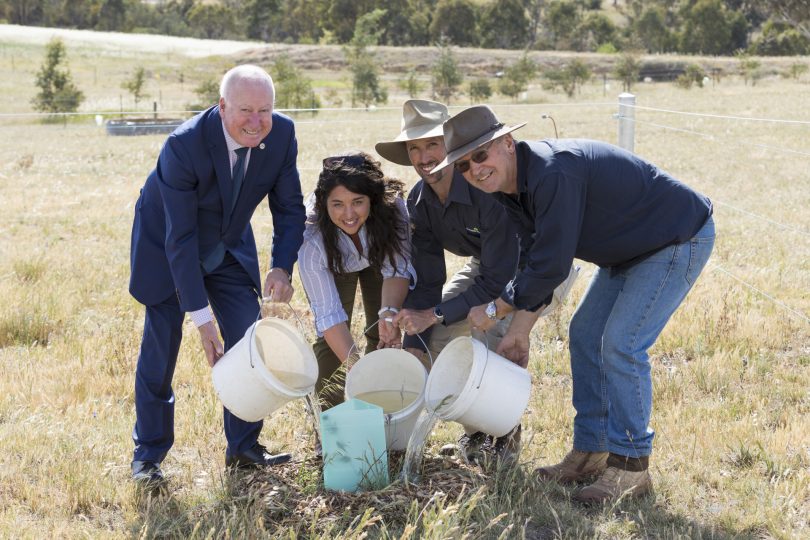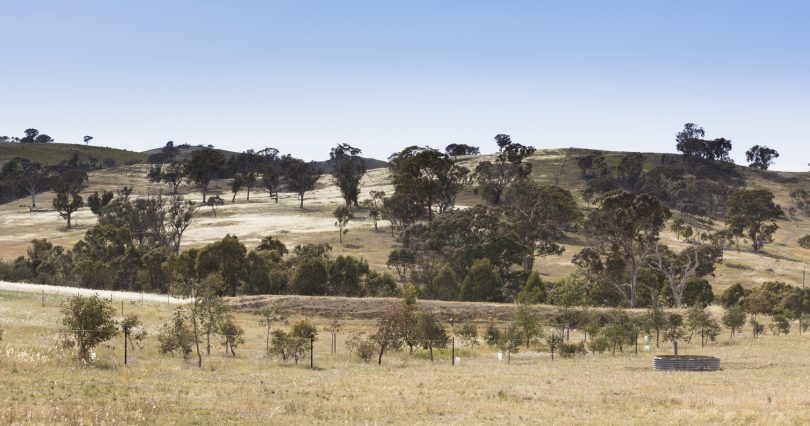
Minister Mick Gentleman, Laura Williams from ACT Natural Resource Management, Graham Fifield from Greening Australia and landowner John Lilleyman water one of the newly planted trees at Amberly Farm, Kambah. Photos: Michelle Kroll, Region Media.
While Carol and John Lilleyman have a couple of Maremma dogs guarding 1000 hens on their 40-hectare property at Kambah, they have always been looking at how trees can protect their land.
The Lilleymans mostly use their farm for free-ranging hens that provide their Amberly Eggs, though a crop of garlic may find its way to a few places soon, too. As farmers, they know they need to diversify so have moved away from cattle farming, but they also realise that a healthy ecosystem will hold their land together.
They recently planted more than 900 trees that provide shade and shelter for their remaining cattle and grazing hens.
Just as the Amberly hens need fresh pasture to graze on, the wider landscape is being revegetated in a similar way.
“I’ve always believed in how having trees can help protect the land,” says Mr Lilleyman. “Some may disagree, but you only have to look at the areas that surround where a tree has been growing to see the micro-climate underneath.
“As the climate has been changing, we’ve moved away from cattle, which require a regular source of pasture, to other enterprises such as eggs, which are less dependant on rainfall. We’re having to adapt like everybody else.”
Mr Lilleyman made the comments as the Minister for the Environment and Heritage, Mick Gentleman, unveiled the ACT Native Woodland Conservation Strategy. The Strategy will guide the protection, restoration and management of our precious lowland and subalpine woodlands for the next 10 years.
A separate five-year strategy to protect and connect box-gum woodlands in the ACT project complements the new woodlands strategy.
Mr Gentleman said the strategies will help land managers improve woodlands with more revegetation, pest and weed control, fencing and strategic grazing.
“Collaborations have already begun on several farms across the region to rehabilitate and revegetate paddocks to enhance box-gum habitat and connectivity across the ACT,” Mr Gentleman said.

Revegetated land at Amberly Farm, near Kambah, with three-year-old native trees in the foreground.
About 70 per cent of ACT’s 79,000 hectares of woodlands are managed and protected by the ACT Parks and Conservation Service and community groups in ACT reserves. Many species, including the superb parrot and little eagles, are critically endangered.
“Many cultural sites important to Traditional Custodians are also located in woodlands, and we know Canberrans value woodland areas for recreation, exercise and wellbeing,” said Mr Gentleman.
“We are committed to preserving and improving what you love most about the bush capital, unlike the Canberra Liberals who have vowed to bulldoze forests for costly urban sprawl.”
Mr Lilleyman welcomed the strategies that will identify how the ACT Government will manage threats, work with the community, safeguard threatened species, enhance resilience and connectivity, and undertake monitoring and research.
“We are great believers in tree cover,” he said. “Not only does it help with grass growth, but the connectivity of having isolated clumps of trees dying off have to be addressed.
“We have put in about 900 trees this year. They provide shade for cattle and the hens really appreciate some shade as well.”
The $1.5 million project is funded through the Australian Government’s National Landcare Program and delivered with help from Greening Australia and the Molonglo Conservation Group.
Greening Australia’s senior project manager Graham Fifield said they are at the coalface of striking a balance between farmers’ connection to their land.
He said the Amberly farm is a very effective example of how ‘stepping-stone type plantings’ connect patches of old trees to remnant woodlands without being a huge impost on the ecosystem.
“This whole-of-paddock rehabilitation concept is about a temporary exclusion of livestock that returns trees and shrubs in a way that complements agriculture rather than competes with it,” Mr Fifield said.
“We’re now looking at systems of alley-farming where up to 25 per cent of a paddock is strategically revegetated in a very deliberate way that maximises biodiversity outcomes and the production outcomes as well.”
The ACT’s Native Woodland Conservation Strategy replaces the current Lowland Woodland Conservation Strategy, which guided significant progress in the protection, restoration and management of woodlands since 2004.
The Strategy and actions plans for threatened species are available on the Your Say section of the ACT Government website.

From left: Laura Williams from ACT Natural Resource Management, Graham Fifield from Greening Australia, Karen Williams from Molonglo Conservation Group, Minister for Environment and Heritage Mick Gentleman, and landowners Carol and John Lilleyman from Amberly Farm.












